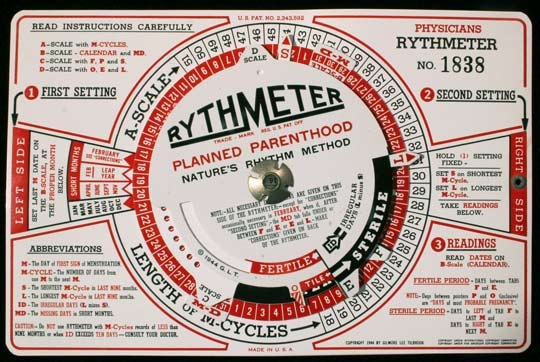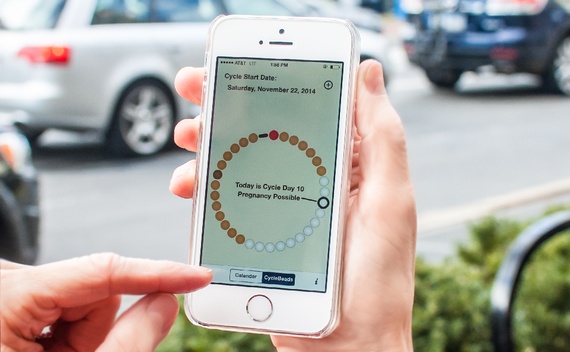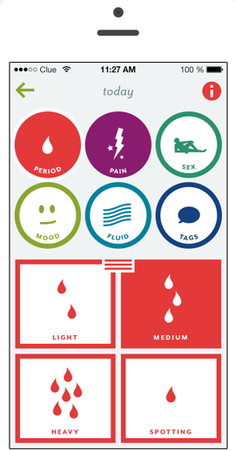
Lauren Giordano/The Atlantic
Return of the Rhythm Method
Tired of condoms and the Pill, many women are turning to new apps that help them practice one of the oldest forms of contraception.
Every morning when she wakes up, Becca, a college student in Pennsylvania, puts a teardrop-shaped thermometer called the Daysy under her tongue. If it lights up green, she knows that day she and her boyfriend can have sex without a condom. If it’s red or yellow, they need to use protection.With its blinking face and patented “LadyComp algorithm,” Daysy seems newfangled, but its core technology is one septuagenarians would recognize. It relies on the basal body-temperature method of family planning, based on the fact that women’s bodies are a few degrees hotter just after ovulation. But while in past decades women who employed this method had to hand-chart their temperatures on graph paper, Daysy tracks the readings automatically and ports the data onto a companion iPhone app that lets the user see her “cycle forecast” and “temperature curve.” Because it’s personalized, it claims to predict a woman’s chance of pregnancy with an accuracy of 99.3 percent—roughly the same as that of birth-control pills.
Becca began using Daysy in June after stints on the Pill and on Nuvaring, the hormonal vaginal ring. (All of the women in this story asked me to use only their first names.) Both methods caused mood changes that she found unsettling, such as bouts of unexplained crying, and the Pill made her nauseous nearly every morning. She and her boyfriend had been together for a while, so although he was wary of “natural” contraception at first, the Pill’s nasty effects on Becca persuaded him to give it a try.
Becca has about 10 “green” days a month, and at other times, the couple uses condoms.
“At first, remembering to measure it every morning, it was hard,” she said. “But you just get in a routine.”
* * *

Meanwhile, the majority of young people live with their partners before marriage, in many cases forming pseudo-marriages that the writer Ann Friedman dubbed “the pullout generation” in New York magazine last year. With a pack of Plan B close at hand, many young women in long-term relationships are eager to prioritize sexual pleasure and to rid themselves of daily synthetic hormones. (And to be sure, many of these women also have sufficient financial resources and relational stability not to fear a mis-timed pregnancy.) The same CDC study found that the number of women whose partners sometimes rely on “withdrawal” for birth control has increased to 60 percent, from 25 percent in 1982.
As of 2010, only about 22 percent of women used “periodic abstinence," an umbrella term that includes counting days, measuring temperature, and tracking cervical mucus to predict fertility. Women with a master’s degree or higher were far more likely to use these methods than their less-educated peers. Their ranks may grow, though, as new apps and other technologies make it easier to manage the historically error-prone task of measuring, recording, and analyzing one’s cycle in order to stay baby-free.

Kate, a woman who lives in the Washington, D.C. area, began using CycleBeads nearly three years ago after experiencing weight gain and moodiness on the Pill. These days, before she and her husband have sex, she reaches for her phone, checks the app, and "we discuss and plan accordingly.”
“At first [my husband and I] were worried,” she said, “but then we got used to it and have grown to trust it. I honestly can't imagine ever going back on the Pill.”
“My husband has been known to pop the thermometer in my mouth when I wake up and remind me to do cervical checks in the evening,” she said. “It's brought us closer than ever because he's so in tune with my body and my natural cycles.”
* * *

None of the women I contacted said they had any slip-ups or unintended pregnancies, and some said fertility awareness was just as easy to handle as the Pill or condoms. Rachel even described it as “like breathing.”
However, several of them emphasized that there’s a difference between what they do and the “rhythm method,” a different kind of days-counting technique developed in the 1930s, which doesn't use temperature readings and which has a historical association with the Roman Catholic church.
Also important is the distinction between apps like Daysy’s and CycleBeads, which are specifically designed for contraception, and those that only track ovulation for couples who are trying to get pregnant. (Clue doesn't officially bill itself as birth control, for example.) Experts don’t recommend simply repurposing a basic fertility app for contraceptive purposes.
The American College of Obstetricians and Gynecologists said in a statement that, "Natural family planning is not as effective as most other methods of birth control. One in four women who use this method become pregnant." The organization also said that women who have abnormal bleeding, vaginitis, cervicitis, frequent fevers, or who are on certain medications should not use these methods.
Nathaniel DeNicola, an OB-GYN with the University of Pennsylvania, said natural methods are “definitely not the most effective,” but can nevertheless be a good option for women who are fed up with hormonal methods, leery of copper IUDs, or have health risks that preclude taking the Pill. Because being off by even a few days can result in pregnancy, he says it’s essential women track their days and symptoms vigilantly—and if apps can help with that, so be it.
As with any contraceptive, there are downsides. Becca shelled out $300 for the Daysy; unlike the Pill, it’s not covered by health insurance. She says she still sometimes struggles to remember to take her temperature in the mornings, and a night of drinking can skew the data.
Heyer says women who have very long or short cycles shouldn’t use CycleBeads, and neither should women who have unpredictable or casual sex. And she realizes that there’s still stigma around natural family planning, especially decades after a hard-won fight by feminists for the current, widespread availability of the Pill.

For several of the women I contacted, the tools also matter as a way to quantify and analyze menstruation, traditionally a taboo subject. Several women reported feeling more in touch with their bodies or impressed by the swooping curves and technicolor data points their uteruses generate, month after month.
“I'm doing a Ph.D in cognitive science,” said Greta, a German woman who asked to be identified pseudonymously and who uses Clue, but only to track her cycle.
“I like data. I also like that Clue empowers me to keep track of my own data, and that their attitude (design, information, everything) respects the fact that I'm an intelligent human who can make scientifically-based decisions.”
There’s another, often overlooked, stylistic element that got her hooked:
“I love that it’s not pink.”

No comments:
Post a Comment